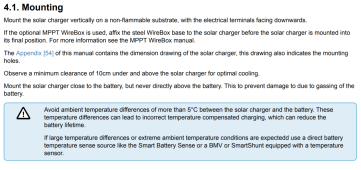sunshine_eggo
Happy Breffast!
Looks great ?
But I don't understand the difference to the shunt suggested in technical terms re Lead-acid, but am certainly happy to use something that is much easier to mount and 50% cheaper. Maybe someone in this thread is able to comment?
It's a Hall effect sensor. It measures the magnetic field around the wire and computes a current.
A shunt is a resistor. Current is calculated based on the voltage drop across the resistor.
They do the same thing using different methods.
You are most certainly correct, well spotted @sunshine_eggo. Given Victron is 3mm shorter width ie 130mm (vs 133 × 71 × 34 mm is my existing PWM) I believe I could still mount Victron unit and have it jutting out from current vertical backboard 186mm, like a shelf, to look down upon controllers interface instead. After doing some measurements it will fit with superfine tolerance of error, but I believe I can do it, see mock-up below.
View attachment 79040
Victrons are designed to be vertically mounted. Otherwise, their cooling fins are not nearly as effective.
I dont understand why, but I will take your word on that.
Because the Victrons are limited to 100V. 3S of your panels would be about 120V.



